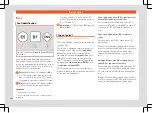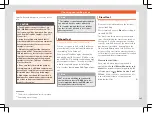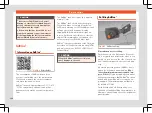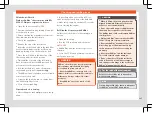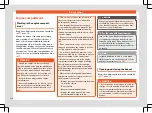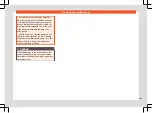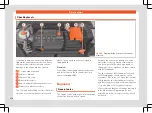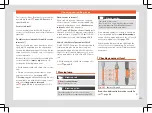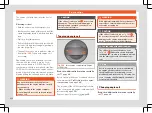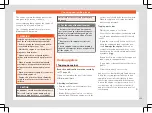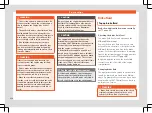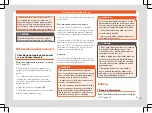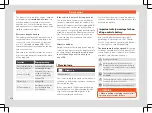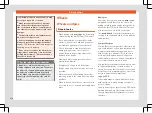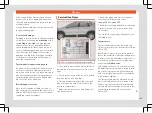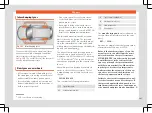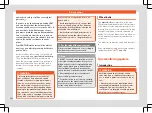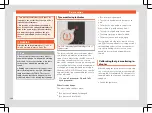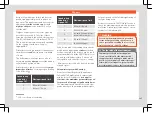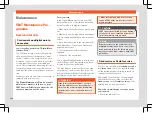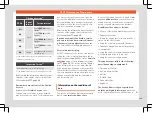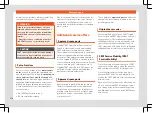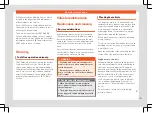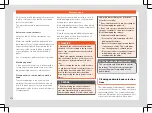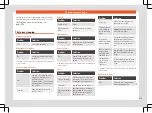
Practical tips
considerably reduced and the vehicle may
not stop on repeated occasions.
●
Make sure that the vent hose is always
attached to the original opening on the
side of the battery. Gases or battery acid
can otherwise escape and possibly cause
damage.
●
The battery holder and clamps must al-
ways be correctly secured.
●
Before starting any work on the battery,
always observe the warnings listed under
page 356, Important safety warnings for
●
Do not forget to replace the battery cov-
erings, where applicable. It is a protection
for high temperatures. This in turn extends
the vehicle service life.
For the sake of the environment
Batteries contain toxic substances in-
cluding sulphuric acid and lead. They must
be disposed of appropriately and must not
be disposed of with ordinary household
waste. Make sure disconnected batteries
cannot tip over. Sulphuric acid could be
spilt!
Wheels
Wheels and tyres
General notes
–
When driving with
new tyres
, be especially
careful during the first 500 km (300 miles).
–
If you have to drive over a kerb or similar
obstacle, drive very slowly and as near as
possible at a right angle to the obstacle.
–
Check from time to time if the tyres are
damaged (punctures, cuts, cracks or
dents). Remove any foreign objects em-
bedded in the treads.
–
Damaged wheels and tyres must be re-
placed immediately.
–
Keep grease, oil and fuel off the tyres.
–
Replace any missing valve caps as soon as
possible.
–
Mark the wheels before taking them off so
that they rotate in the same direction when
put back.
–
When removed, the wheels or tyres should
be stored in a cool, dry and preferably dark
place.
New tyres
New tyres do not give maximum
grip
straight
away and should therefore be “run in” by
driving carefully and at moderate speeds for
about the first 500 km (300 miles). This will
also increase the useful life of the tyres.
The
tread depth
of new tyres may
vary
, ac-
cording to the type and make of tyre and the
tread pattern.
Low profile tyres
Low profile tyres, compared to other rim and
tyre combinations, offer a broader tread and
a greater rim diameter along with a lower
height of the tyre sidewall. This results in a
more agile driving behaviour. However, on
roads that are in poor condition, this might af-
fect comfort and cause more noise.
Low profile tyres may deteriorate more quick-
ly than standard tyres, for instance due to
strong knocks, potholes, manhole covers and
kerbs. Therefore, maintaining the correct tyre
pressure is particularly important
To avoid damage to tyres and wheels, drive
with special care when driving on roads in
poor condition.
Visually inspect your tyres every 3,000 km re-
garding damage, e.g. flattening/cracks on
the tyre sidewall or deformations/cracks on
the rims.
358
Summary of Contents for Ateca 2018
Page 1: ...Owner s manual SEAT Ateca 575012720BG Inglés 575012720BG 07 18 SEAT Ateca Inglés 07 18 ...
Page 105: ......
Page 106: ...Operation Fig 121 Instruments and controls 104 ...
Page 390: ...Technical data Dimensions Fig 314 Dimensions Fig 315 Angles and ground clearance 388 ...
Page 392: ......
Page 409: ......
Page 410: ......
Page 412: ...Owner s manual SEAT Ateca 575012720BG Inglés 575012720BG 07 18 SEAT Ateca Inglés 07 18 ...

